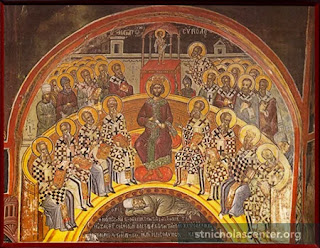The Second Council of Nicaea: Iconoclasm Conquered and Icons Revered
The Second Council of Nicaea, convened in 787 AD, stands as a pivotal moment in the history of Christianity. This Seventh Ecumenical Council was called to address the heated and divisive issue of iconoclasm - the controversy over using religious icons and images in Christian worship.
In the early centuries of Christianity, icons were a subject of theological debate. Iconoclasts argued that the veneration of religious images constituted idolatry, a grave sin in Christianity. On the other hand, Iconophiles believed that icons served as aids to devotion, helping to deepen the spiritual connection between believers and the divine. The controversy reached its zenith in the 8th century, threatening to splinter the Christian Church.
The Council, held in the city of Nicaea in Turkey, was convened by Empress Irene of Athens and her son, Emperor Constantine VI. It brought together hundreds of bishops, theologians, and religious leaders from across the Christian world. Their mission was to settle the iconoclastic dispute and chart a path forward for the Church.
The Council's decisions were profound and nuanced. It unequivocally condemned iconoclasm, affirming the legitimacy of icons and images in Christian worship. These images, the Council proclaimed, were not objects of worship but means of expressing and enhancing Christian faith. They underscored the distinction between the veneration of the persons depicted in the icons - such as Jesus Christ, the Virgin Mary, and the saints - and the worship of the physical images themselves.
Furthermore, the Council provided specific guidelines for the appropriate use and veneration of icons. It called for reverence in handling and displaying them, emphasizing their role as aids to devotion. The rulings fostered a deeper understanding of the spiritual significance of icons, leading to the creation of some of the most iconic religious artworks in history.
The long-term impact of the Second Council of Nicaea has been profound. It decisively resolved the iconoclastic controversy, contributing to the consolidation of Orthodox Christian theology and practice. The theological principles laid out at the Council continue to shape the worship practices of Eastern Orthodox Christianity. The veneration of icons remains a central element of Orthodox spirituality, with these images adorning churches and homes, serving as windows to the divine.
In addition to its theological significance, the Council reaffirmed the importance of ecumenical councils in resolving doctrinal disputes within Christianity. It left a lasting legacy in the realm of faith and worship and the world of art and culture, where the Eastern Orthodox tradition continues to produce exquisite religious iconography. With its profound impact, the Second Council of Nicaea remains a testament to the enduring power of faith and the ability of human wisdom to reconcile even the most divisive of disputes.


Comments
Post a Comment